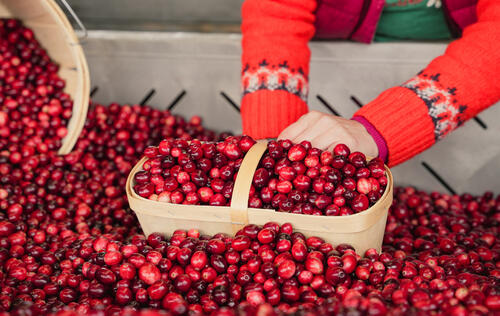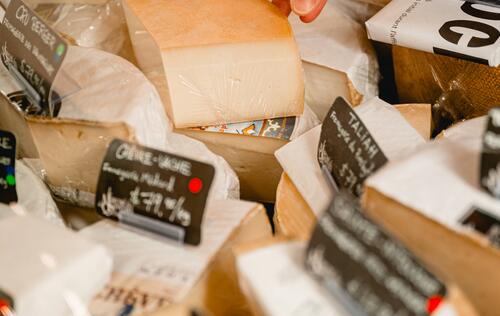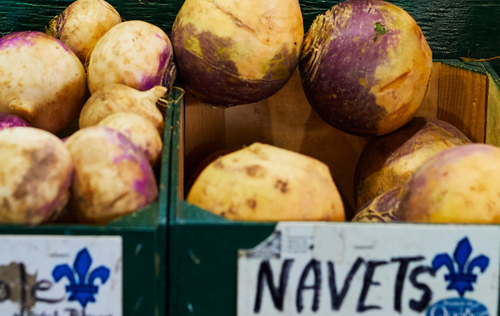Local seasoning basics for the locavore apprentice

Situation: you're on the programme La guerre des clans and you're asked to name 6 local flavours. What comes quickly to mind? Without hesitation: maple! Then maybe strawberries or blueberries. If you're feeling original, maybe fir or spruce? And if I mention herbs, seaweed, camelina, sumac, sweet clover or even balsam myrtle, does that ring a bell?
Boreal spices
Although little known, these tasty and unique boreal flavours deserve to be explored and added to our spice shelves. Tame them gradually and maybe they'll eventually become part of our cooking reflexes, and why not maybe they'll end up displacing some of the more exotic options.
Sweet clover
The famous ‘Quebec vanilla’ you've probably already heard of. It has an essence of almond and vanilla that's perfect in desserts. You'll find it in dried or essence form, and both will be your new best friends when it comes to making sweet treats!
Sumac vinegar
Sumac is often used in Middle Eastern cuisine. It can give a very interesting tangy touch to dishes. Try it in vinaigrettes, marinades, spreads, on fish or as a substitute for lemon in a variety of recipes. Some Quebec families have been making sumacade, a lemonade made from sumac, for generations. Keep your eyes peeled for this plant just about everywhere: on the side of the road, in the park and even in your own backyard!
Balsam Myrtle
A slightly resinous flavour reminiscent of bay leaves, nutmeg and... gin! In fact, this ingredient is often found in recipes for good Quebec gins. All you have to do is learn to tame it, and once you do, you'll never want to part with it again! In jams, in marinades with game meats or fatty fish, in stews and casseroles, as a garnish on pastries and wherever your imagination takes you!
Crunchy pepper
Also known as dune pepper, it is both peppery and fragrant, with resinous and floral notes. Use in marinades, stews, jellies, jams and chutneys. It can also be used to replace traditional pepper.
Discovering seaweed
Today, seaweed can be found dried and processed just about everywhere. I try to incorporate them more and more into my dishes, and very often they allow me to replace the touch of table salt that I would have added. Wakame, royal kombu, sweet kelp, sea bacon, kelp, nori and sea lettuce are all seaweeds with surprising flavours all their own! Discover them one by one by adding them to a cold soup, smoothie, dip, stew, sushi or vegetable bowl, or simply by adding them to hot water to make an express vegetable broth, and the list goes on!
Vinegars: much more than just balsamic
Good old balsamic vinegar! It's been a staple in our kitchens for quite some time now. So much so that we end up forgetting that there are so many other tasty options that have absolutely nothing to envy this vinegar.
Cider vinegar and ice cider vinegar, maple vinegar, raspberry vinegar, dandelion wine vinegar, cranberry wine vinegar and the list goes on! In Quebec, you'll also find verjuice. This is an acidic juice extracted from grapes that have not had time to ripen. All these options can undoubtedly replace the vinegars and tropical juices normally used to acidify a dish, and above all they will give your dishes a unique local flavour. By opting for a quality product, I swear you won't miss the zigzag of balsamic at the bottom of the plate as a fancy garnish.
Local oils with unique flavours
We often cook with a variety of rather exotic oils to add extra flavour to a dish. Sesame oil and coconut oil come to mind, and they've probably been used for every possible food and non-food purpose in the last couple of years... Why not try spicing up a dish in the same way, but with flavours that are very much our own?
- Sunflower oil: easy to find just about everywhere. It has a neutral or delicate sunflower and nut flavour. It lends itself well to cooking.
- Hemp oil: has a rather pronounced herbaceous and nutty flavour. In my opinion, it is a good substitute for a good cold-pressed olive oil. However, this oil should be avoided in cooking.Ù
- Camelina oil: quite a pronounced herbaceous and nutty flavour, rather delicate, it does not need to be used in large quantities to give a characteristic flavour to a dish. It can be used in cold dishes as well as in low-heat cooking.
- Canola oil: rather neutral and delicate aromas of nuts and hazelnuts. It can easily be used in cooking.
Des réserves d’herbes fraîches pour l’année
Of course, if you don't feel quite ready to explore the options presented so far, you can always opt for well-known and accessible herbs. Fresh herbs offer a variety of flavours, and the end of summer is the perfect time to preserve them for the rest of the year! And let's face it, it's a lot better than a commercial dried oregano base that tastes like sweeper dust.
So here are a few highly flavoursome strategies you can apply to make your dishes taste like summer in every season:
- The classic and indisputable pesto still has its place in the kingdom of preserved basil. Why not opt for the same processing technique for different herbs? Dill, rocket, parsley, coriander, carrot leaves... let your imagination run wild.
- An even quicker and simpler alternative to pesto is to simply freeze the herbs in a little oil to preserve their aromas.
- For herbs with stronger flavours, such as thyme, rosemary or sage, a very interesting and simple option is to add them to a little softened butter. Why not also add a little candied garlic or dried tomatoes from the garden and finish by seasoning to taste? Then freeze in small portions. Use as much as you like for scones, savoury muffins, baking, on bread - you name it! I know! Sorry, I've just created an addiction.
- Certain herbs such as thyme, rosemary, sage and parsley can also be simply dried.
- Don't forget to collect the seeds of herbs that are also very rich in flavour, such as coriander seeds, dill seeds or fennel seeds.
We hope these different aromatic paths will inspire you and, above all, allow you to make a little more room for Quebec flavours in your spice cabinet! Happy discoveries!
A selection of local seasonings available from Montreal's public markets
Les Douceurs du Marché
Location: Atwater Market
Facebook: Les Douceurs du Marché
Boutique aux Champêtreries
Location: Maisonneuve Market
Les Jardins Sauvages
Location: Jean-Talon Market
Website: www.jardinssauvages.ca
Facebook: Les Jardins Sauvages
Épices de Cru
Location: Jean-Talon Market et en ligne
Website: epicesdecru.com
Facebook: Épices de Cru
Les Épices du Guerrier
Location: Marché Jean-Talon et en ligne
Website: epicesduguerrier.com
Facebook: Épices du Guerrier
Le Marché des Saveurs du Québec
Location: Marché Jean-Talon
Website: lemarchesdessaveurs.com
Facebook: Le Marché des Saveurs du Québec
Fines Herbes et Ail Patrick Lauzon
Location: Marché Jean-Talon
Website: chacunsonarome.com
Facebook: Fines Herbes Patrick Lauzon / Chacun son arôme
This article was written by Édith Ouellet, a nutritionist by profession, who believes that healthy eating and sustainable eating go hand in hand. With her very own 0% guilt-tripping style, she tries to influence people to adopt eating habits that are not only healthier but also more respectful of the planet's health. Édith is offering a brand new course to support you in your efforts to eat locally all year round. With recipes, tips, tricks and answers to all your questions, you'll learn the essentials for becoming a true locavore... even in Quebec!




